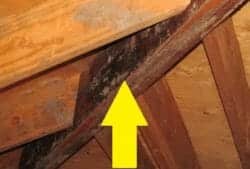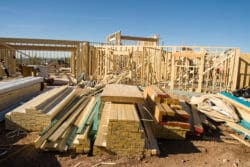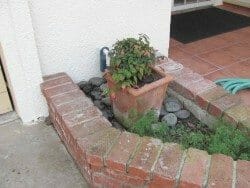Is Lumberyard Mold In A Home Serious?

Lumberyard mold is often observed when a contractor has received a load of lumber from the lumberyard and he notices that there are dark colored stains or mold on the lumber. At times, there may be dark, brownish, blueish or a whitish discoloration depending on the type of tree, the cut and the type of mold or fungus. Usually it is not on all the pieces and if a piece of lumber has discoloration, it is only on a portion of that piece of lumber.
When a tree is cut down, the bark removed and is processed for lumber, nutrients are exposed. These nutrients provide a fertile place for fungal spores to grow and between the moisture in the wood, the rain and humidity, the fungus may grow rapidly. Saw mills and lumberyards often store much of their lumber outside or in open sheds where it gets exposed to rain and even snow in some areas; this provides additional moisture for the growth of mold.
On the construction site
Lumber, once on a construction site, may be exposed to more rain and moisture which contributes to the growth of more spores and mold. Once the framing is started, the home is roofed and the house is wrapped, then the lumber will usually start to dry out. In a few instances the contractor may treat or remove the discoloration or mold and may refer to it as surface mold or mildew and not be concerned that it will affect the structural integrity of the home or present a health hazard.
The code and the Building Department
Contractors are often required by the local building department and code not to use framing lumber that has a high moisture content. Generally, the requirement is that the moisture content be 19% or lower and in some building jurisdictions there are testing requirements to ensure that the wood conforms to their moisture limitations. They may also require documentation that the wood meets their requirements before the contractor installs the drywall over the wood framing.

Homes built with wet lumber
If a house is built with lumber that has a high moisture content, then a number of problems can develop, especially if it’s drywalled prior to the lumber reaching a proper moisture content. When the walls and ceilings of a home are drywalled before the wood framing is dried properly, the moisture gets trapped and the wood fails to dry out properly; this gives any mold and fungus a chance to develop or get stronger. When the moisture content is too high:
- Mold is more likely to develop
- Drywall may crack, especially at window and door areas as the wood dries out, twists and wraps
- Drywall nail or screw heads may pop
- Floors and stairs may squeak
Moisture content levels
Builders and contractor often use the following as their guidelines:
- Wood that has a moisture content of 15% to 17% would be considered dry
- Wood with a moisture content greater than 17% has potential for mold
- Wood with a moisture content of 20% or higher has the potential for wood decay fungi and at 28% or more the probability of wood decay greatly accelerates.
- Cabinets in a home should be built out of lumber with a 5% to 8% moisture content
Older homes
The wood in an average older home in the United States a has moisture content between 5% and 15%, however when there are water leaks, plumbing leaks and wood that is constantly damp or wet, then mold and dry rot may easily develop. Homeowners should keep in mind the importance of fixing leaks immediately and that doing preventive maintenance is key to having a sound and safe house.
Bottom Line
The higher the moisture content of a homes’ framing lumber the more likelihood that fungus, mold and decay will occur, especially if the home is drywalled before the moisture content is under 19%. New homes are susceptible to lumberyard mold, however, when good construction practices are followed then there is less risk from problems arising because of lumberyard mold.



